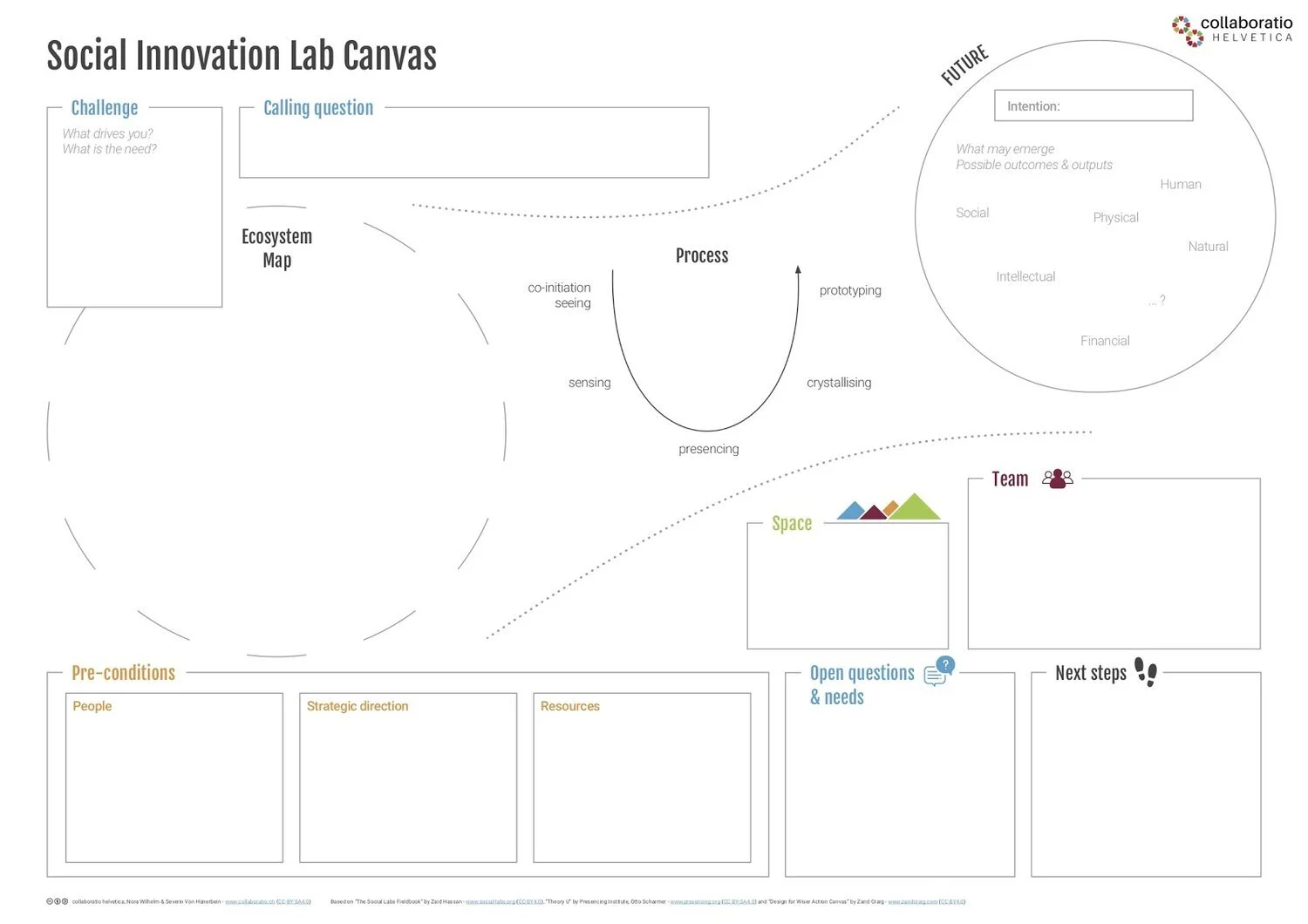Social Innovation Lab Canvas
Catalysing systemic change around a particular issue or topic is complex work, a match for the system you’re addressing and activating. There has been some degree of codification, theory and study around which approaches may help us do so. One of the approaches that has gained traction over the past years is the Lab approach, which in this context means bringing together a variety of stakeholders to co-create prototype solutions to complex challenges. It draws mainly from System Thinking (e.g. Donella Meadows), Theory U (MIT/Otto Scharmer) and the Social Lab concept of Zaid Hassan. Social Innovation Labs, as we call them, are our third iteration (since 2017) on combining these approaches with Art of Hosting, Sociocracy 3.0, dialogue and other awareness-based methods.
You can read more about our take on Social Innovation Labs here, and soon in our field book.
In order to support a catalyst in the process of co-initiating a Social Innovation Lab, we have developed this canvas as a visual aid to your thinking and exploring.
Process
Sit down in a nice and quiet spot
Perhaps meditate or enjoy a few minutes of silence
Look at your Social Innovation Lab Canvas and start by writing down the challenge you are trying to address
Then, map out the system that you are part of that is affected by or inherently intertwined with this challenge. Please refer to the toolbox entry on System Mapping for this step.
From here, you may fill out whatever is already clear in your case - this is different for every Social Innovation Lab. For example, if you already know who’s your team, fill that out. If you already have a funder, note it in the resources section, alongside how much time, money, the energy you think you need. Continue
It’s fair to say that achieving the pre-conditions for a Social Innovation Lab will be 90% of the work. Including the key people, gathering the right team, activating the needed resources and deciding on a strategic direction are all challenging steps. As you go into this, ensure you have the right amount of support, and be ready to let your plan shift and your picture of what the Lab will look like change over time.
Your calling question should be formulated in a way that gives a certain strategic direction and scope, contributing to clarifying who should be part of the Lab. It, therefore, needs to be formulated in such a way that it does not de-facto excludes some of the stakeholders you absolutely must include. For more guidance on how to formulate powerful questions, please refer to this toolbox entry.
In order to design the process, the defining elements include who should be there, where it ought to take place, and how much can you invest in accommodations. For this step, as it is a whole field and profession in and of itself, we recommend you refer to a person whose expertise is designing and facilitating such processes, whom we call Practitioners.
Go easy on the future section, as mentioned it’s part of the DNA of Social Innovation Labs that we need to be open to different types of outputs and outcomes. If we knew what the solution was and how to implement it, we wouldn’t do all this work in the first place. So make sure that you name your intention, and have some sense of what might come out so that you can talk about this to funders and other stakeholders, but don’t get too specific. For example, we ran the Gender Lab so that some new products and services to address the gender discriminations in the workplace would be offered, yet we couldn’t and shouldn’t have tried to predict it would for example include a workshop to create more inclusive organisational cultures.
Also, note your open questions and possible next steps.
Now, what you do from here is up to you! Maybe you’re more of a text person, and this was helpful to get started but you now move on to different types of documentation. We suggest you come back to it regularly, to reflect on your progress in understanding your system and building up the necessary pre-conditions. You could bring it along to any stakeholder interview you do, any upcoming team meetings, or use it to explain your work to a funder.
In any case, we wish you the best of luck and courage for the yet unknown! Don’t hesitate to reach out to us if you need support on your journey, or to apply for the Catalyst Lab if you’re seriously considering walking the path of a systemic change Catalyst.
Note: it is possible to fill this out by yourself, with your team or with a group of peers offering you feedback, for example using the Wise Crowds process we documented here.
Needed time and materials
A printed copy of the canvas web, or a hand-drawn version
A pen or several
Post-its if you want to re-use the canvas later
30+ minutes for self-reflection or filling it out with a group
Sources
Social Innovation Lab Canvas (see picture below)
The Gender Lab, the first Social Innovation Lab on Gender Equality in Switzerland
Societal Transformation Lab by Presencing Institute
Stanford article on Social Labs
Nora Wilhelm is the Co-Founder and Catalyst of collaboratio helvetica. She has a background in youth engagement and active citizenship (European Youth Parliament) and specialised in collaboration, self-organisation, ecosystem leadership, systemic change and social innovation. Beyond facilitating multi-stakeholder processes and social innovation labs as well as promoting the Sustainable Development Goals (SDGs), she is a renowned young leader, advocate and speaker, recognised for her work by the Swiss government, UNESCO, Forbes 30 under 30 and other institutions.


